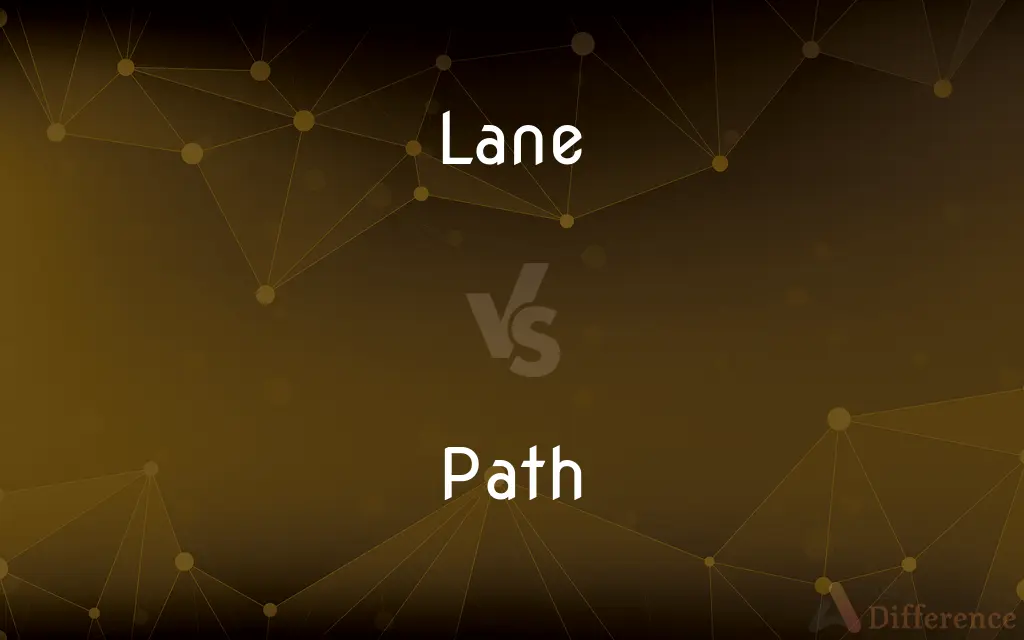Lane vs. Path — What's the Difference?
Edited by Tayyaba Rehman — By Maham Liaqat — Updated on March 30, 2024
A lane is a narrow road or section within a road, often designated for a specific purpose, while a path is a trail or way for walking, not usually accessible by vehicles.

Difference Between Lane and Path
Table of Contents
ADVERTISEMENT
Key Differences
A lane, typically found within the structure of roads, is designated for specific types of traffic or direction, guiding vehicles within larger thoroughfares. Paths, on the other hand, are primarily meant for pedestrians or small non-motorized vehicles, offering a more intimate route through various landscapes.
Lanes serve a critical function in traffic management, often marked on roads to direct vehicular movement. Paths, whereas, meander through parks, forests, or between buildings, focusing on pedestrian accessibility and enjoyment rather than vehicular traffic.
In urban contexts, lanes are essential for organizing complex traffic flows, including bike lanes or bus lanes that cater to specific transportation modes. Conversely, urban paths provide shortcuts and recreational routes for walkers and cyclists, enhancing connectivity without catering to cars.
Lanes are usually paved with asphalt or concrete to support the wear and tear of vehicle tires. Paths may be composed of gravel, dirt, or paved surfaces, depending on their intended use and location, reflecting a closer connection to the natural or designed landscape.
Lanes are subject to traffic laws and regulations, dictating speed limits and the direction of travel. Paths follow local ordinances that might restrict vehicle access, ensuring safety and preservation of the pedestrian experience.
ADVERTISEMENT
Comparison Chart
Definition
A narrow road or section within a road
A trail or way for walking
Primary Use
Vehicle traffic management
Pedestrian or non-motorized vehicle travel
Location
Roads, highways
Parks, forests, urban areas
Material
Asphalt, concrete
Gravel, dirt, paved surfaces
Legal Considerations
Subject to traffic laws
Governed by local pedestrian ordinances
Compare with Definitions
Lane
A section of road marked for a specific purpose.
The city added a bus lane to improve public transport efficiency.
Path
A course of action or way of achieving a specified result.
Choosing a career path can be daunting.
Lane
A narrow way between buildings.
The delivery truck navigated the narrow service lane.
Path
A paved walkway for pedestrians.
The park's new path was lined with flowers.
Lane
A division in a swimming pool designated for individual racers.
She swam faster in her lane during the competition.
Path
A way or track laid down for walking or made by continual treading.
The winding path led them through the forest.
Lane
Part of a roadway designated for particular vehicles.
The right lane is for slower traffic.
Path
A course of direction that something moves.
The storm's path caused widespread damage.
Lane
A narrow road or subdivision within a road.
The cyclist stayed in the bike lane.
Path
A route or track between one place to another.
The scenic path along the lake was breathtaking.
Lane
In road transport, a lane is part of a carriageway that is designated to be used by a single line of vehicles to control and guide drivers and reduce traffic conflicts. Most public roads (highways) have at least two lanes, one for traffic in each direction, separated by lane markings.
Path
A way or track laid down for walking or made by continual treading
The path continues alongside the river for half a mile
Lane
A narrow road, especially in a rural area
She drove along the winding lane
Path
(chiefly in computing and railway contexts) allocate a path.
Lane
A division of a road marked off with painted lines and intended to separate single lines of traffic according to speed or direction
The car moved into the outside lane
A bus lane
Path
A trodden track or way.
Lane
A narrow country road.
Path
A road, way, or track made for a particular purpose
A bicycle path.
Lane
A narrow way or passage between walls, hedges, or fences.
Path
The route or course along which something travels or moves
The path of a hurricane.
Lane
A prescribed course for ships or aircraft.
Path
A course of action or conduct
The path of righteousness.
Lane
A strip delineated on a street or highway to accommodate a single line of vehicles
A breakdown lane.
An express lane.
Path
A sequence of commands or a link between points that is needed to reach a particular goal.
Lane
(Sports) One of a set of parallel courses marking the bounds for contestants in a race, especially in swimming or track.
Path
A pathname.
Lane
(Sports) A wood-surfaced passageway or alley along which a bowling ball is rolled.
Path
A trail for the use of, or worn by, pedestrians.
Lane
(Sports) An unmarked lengthwise area of a playing field or ice rink viewed as the main playing area for a particular position, such as a wing in soccer.
Path
A course taken.
The path of a meteor, of a caravan, or of a storm
Lane
(Basketball) The rectangular area marked on a court from the end line to the foul line.
Path
(paganism) A Pagan tradition, for example witchcraft, Wicca, druidism, Heathenry.
Lane
(used in street names) A road, street, or similar thoroughfare.
Penny Lane
Path
A metaphorical course or route; progress.
Lane
A narrow passageway between fences, walls, hedges or trees.
There's a shortcut to the shops through this leafy lane.
Path
A method or direction of proceeding.
Lane
A narrow road, as in the country.
Path
(computing) A human-readable specification for a location within a hierarchical or tree-like structure, such as a file system or as part of a URL.
Use the network path
\\Marketing\Files to find the documents you need.Lane
A lengthwise division of roadway intended for a single line of vehicles.
Drivers should overtake in the outside lane
We were held up by a truck in the middle lane of the freeway.
The exit lane
Path
(graph theory) A sequence of vertices from one vertex to another using the arcs (edges). A path does not visit the same vertex more than once (unless it is a closed path, where only the first and the last vertex are the same).
Lane
A similar division of a racetrack to keep runners apart.
There are eight lanes on an Olympic running track.
Path
(topology) A continuous map from the unit interval to a topological space .
Lane
Any of a number of parallel tracks or passages.
The checkout lanes in a supermarket
A swimming lane
Path
(rail) A slot available for allocation to a railway train over a given route in between other trains.
Lane
A course designated for ships or aircrafts.
Shipping lane
Path
Pathology.
Lane
(bowling) An elongated wooden strip of floor along which a bowling ball is rolled.
We booked a couple of lanes at the bowling alley.
Path
(transitive) To make a path in, or on (something), or for (someone).
Lane
(card games) An empty space in the tableau, formed by the removal of an entire row of cards.
Path
To navigate through a file system directory tree (to a desired file or folder).
Next, you need to path to the location of the executable and run it from there.
Lane
(computing) Any of the parallel slots in which values can be stored in a SIMD architecture.
Path
A trodden way; a footway.
The dewy paths of meadows we will tread.
Lane
(video games) In MOBA (multiplayer online battle arena) games, a particular path on the map that may be traversed by enemy characters.
Path
A way, course, or track, in which anything moves or has moved; route; passage; an established way; as, the path of a meteor, of a caravan, of a storm, of a pestilence. Also used figuratively, of a course of life or action.
All the paths of the Lord are mercy and truth.
The paths of glory lead but to the grave.
Lane
(horse racing) The home stretch.
And it's Uncle Mo in front by two as they come to the top of the lane.
Path
To make a path in, or on (something), or for (some one).
Lane
Alone.
Path
To walk or go.
Lane
A passageway between fences or hedges which is not traveled as a highroad; an alley between buildings; a narrow way among trees, rocks, and other natural obstructions; hence, in a general sense, a narrow passageway; as, a lane between lines of men, or through a field of ice.
It is become a turn-again lane unto them which they can not go through.
Path
A course of conduct;
The path of virtue
We went our separate ways
Our paths in life led us apart
Genius usually follows a revolutionary path
Lane
A narrow way or road
Path
A way especially designed for a particular use
Lane
A well-defined track or path; for e.g. swimmers or lines of traffic
Path
An established line of travel or access
Path
A line or route along which something travels or moves;
The hurricane demolished houses in its path
The track of an animal
The course of the river
Common Curiosities
Can a lane ever be used by pedestrians?
Yes, lanes like bike lanes or emergency lanes may occasionally accommodate pedestrians, especially in areas lacking sidewalks.
How do municipalities decide to designate lanes on roads?
Municipalities consider traffic flow, safety, and specific needs like bus routes or bike traffic to designate lanes on roads.
Is a path the same as a sidewalk?
A path and a sidewalk serve similar purposes for pedestrians, but sidewalks are typically adjacent to roads, while paths can traverse more varied landscapes.
Do lanes have to be straight?
Lanes generally follow the curvature of the road but are essentially linear to guide vehicles efficiently.
How are paths maintained?
Paths are maintained by local authorities or private owners, involving landscaping, surface repairs, and cleanliness.
What makes a bike lane different from a regular lane?
A bike lane is specifically designated for cyclists, marked by signs and road paintings, whereas regular lanes accommodate motor vehicles.
Are there paths accessible to bicycles?
Yes, many paths are designed to be shared by pedestrians and cyclists, especially in parks and recreational areas.
Can lanes change direction based on time of day?
Yes, some lanes, especially in urban areas, can be designated as reversible, changing direction during peak traffic times.
Can paths be private?
Yes, paths can be privately owned and restricted to public access, especially in gated communities or private parks.
Are paths safer than lanes?
Paths are generally safer for pedestrians and cyclists as they are separated from motorized traffic.
Can a lane be temporarily closed?
Yes, lanes can be temporarily closed for construction, events, or emergencies.
How are lanes and paths marked?
Lanes are marked with road paint and signs, while paths may have signs, markers, or natural boundaries.
Do paths contribute to urban greenery?
Paths, especially those in parks or natural areas, contribute to urban greenery and provide eco-friendly routes.
What's the difference between a footpath and a path?
A footpath is specifically for walking, while a path can be used for walking and sometimes cycling or other non-motorized forms of travel.
How do emergency vehicles navigate lanes and paths?
Emergency vehicles navigate lanes with priority, using sirens and lights, and can access certain paths if necessary for rescue or emergency services.
Share Your Discovery

Previous Comparison
Empty vs. Blank
Next Comparison
Sawed vs. SawnAuthor Spotlight
Written by
Maham LiaqatEdited by
Tayyaba RehmanTayyaba Rehman is a distinguished writer, currently serving as a primary contributor to askdifference.com. As a researcher in semantics and etymology, Tayyaba's passion for the complexity of languages and their distinctions has found a perfect home on the platform. Tayyaba delves into the intricacies of language, distinguishing between commonly confused words and phrases, thereby providing clarity for readers worldwide.
















































